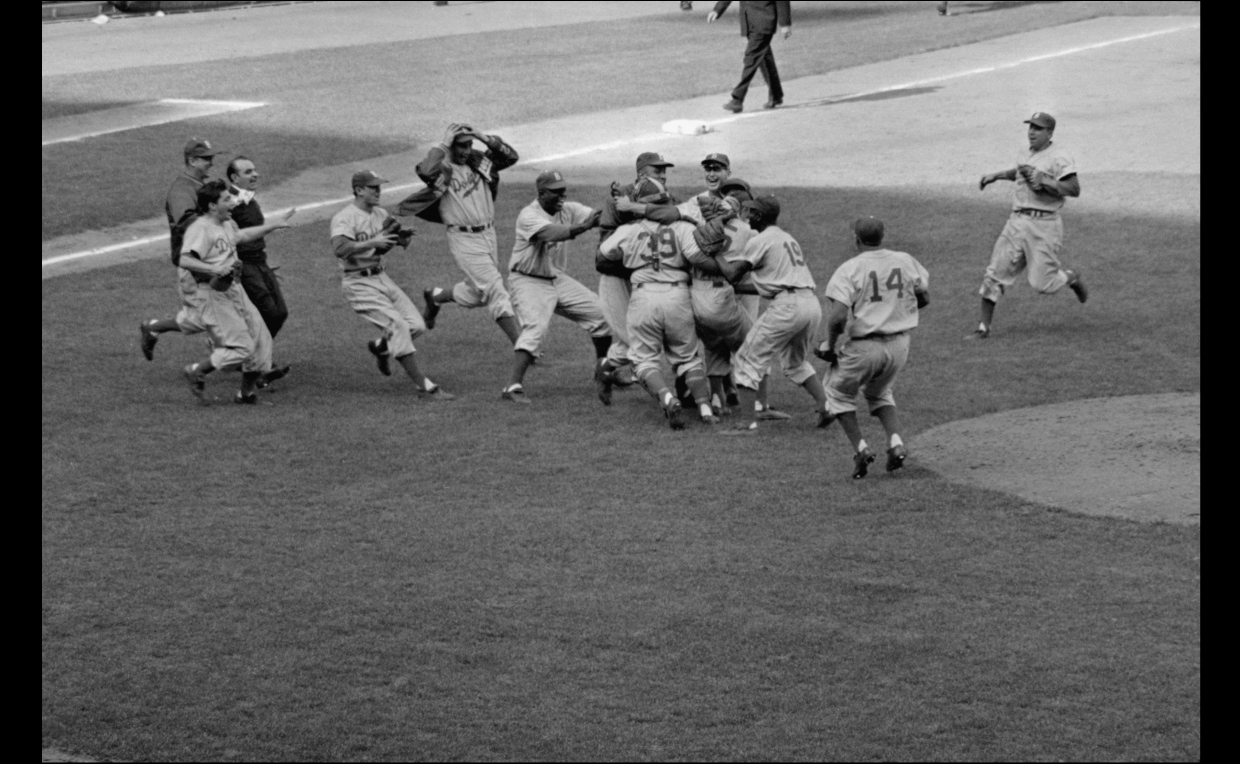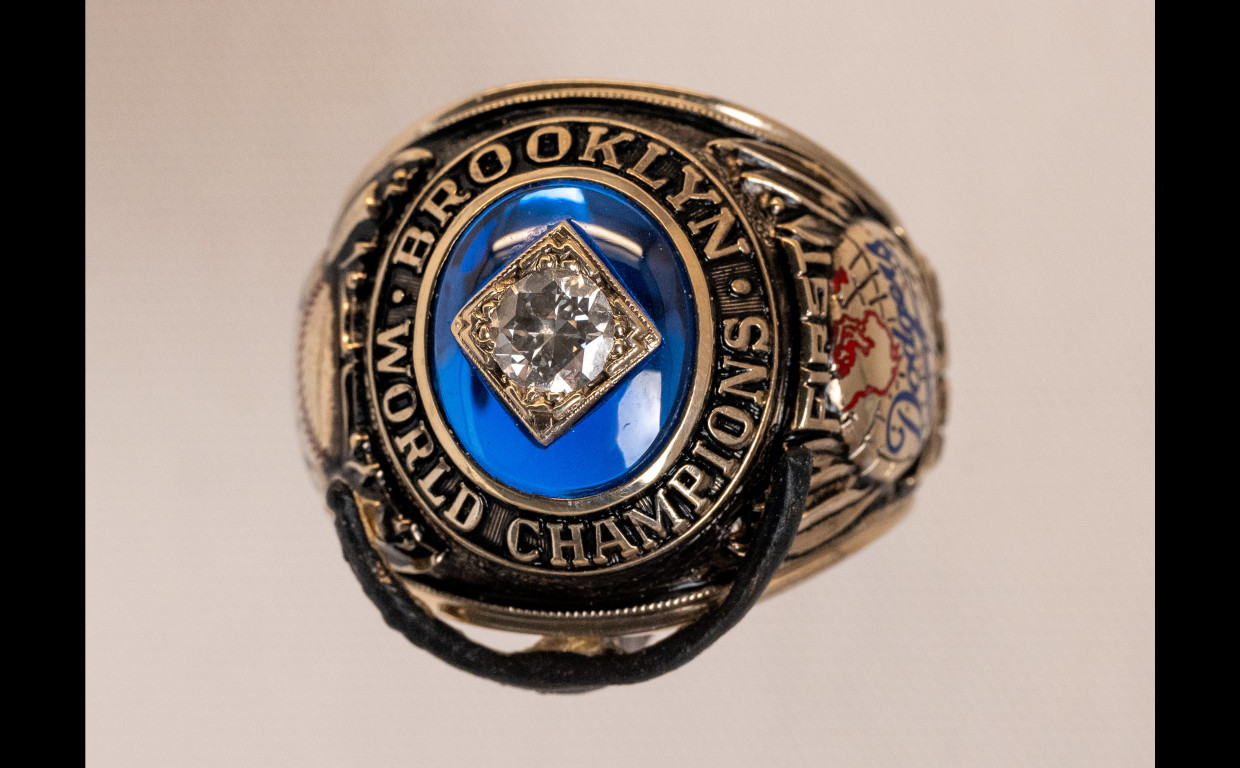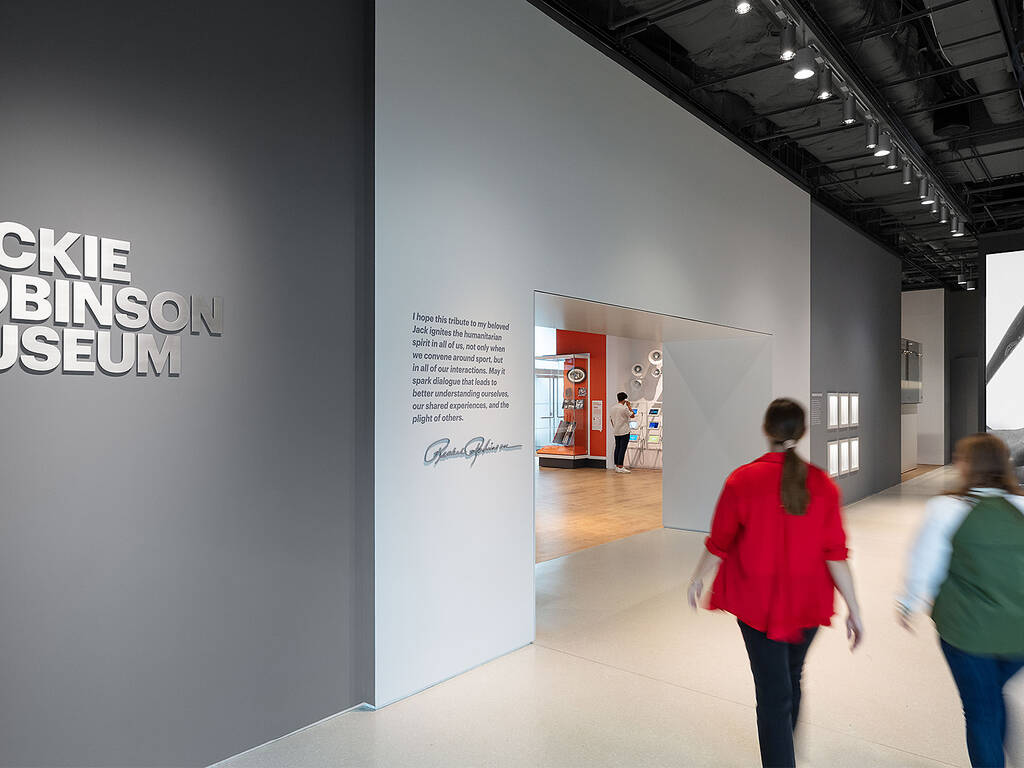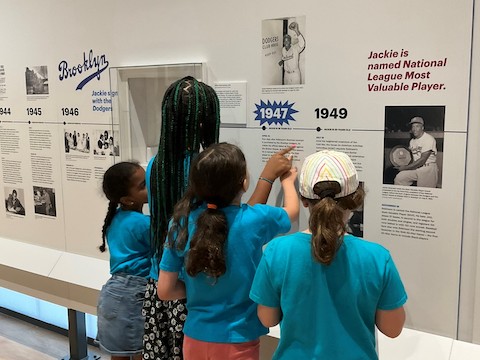
News
The Jackie Robinson Museum Is About a Lot More Than Baseball
Robinson accomplished a great deal on the field, but a museum celebrating his life puts as much focus on his civil rights work.
READ MOREPlan your visit or become a member today!
Last week, we explored Jackie’s performance in the 1947, 1949, and 1952 World Series, as well as a “phantom” program from the never-played 1951 Dodgers-Yankees matchup. As the series returns to New York, we will look at Robinson’s four other World Series against the Yankees between 1953 and 1956. In celebration of the historic Dodgers-Yankees rivalry, the Jackie Robinson Museum will be open for special hours on Tuesday, October 29 and Wednesday, October 30 from 11AM to 6PM!

Dodgers players mob pitcher Johnny Podres after he pitches a complete game shutout in the 1955 World Series. Getty Images
After their crushing defeat in 1952, the Dodgers returned to the World Series the next year. Winning an impressive 105 games, the Dodgers cruised to the National League pennant, coming in thirteen games ahead of Milwaukee. Again, they were pitted against the New York Yankees, who were looking to add to their streak of World Series victories. The 1953 Brooklyn Dodgers are considered one of the best teams of all time. Expectations were high, even though the Yankees were considered 6-to-5 favorites. Even Jackie didn’t want to seem overconfident: “I don’t want to bat 1.000,” he said before the series started. “I just want to get a hit at the right time.”
Robinson, of course, did not bat 1.000, but he had his most successful World Series to date. After getting only a single hit across the Dodgers’ losses in Games 1 and 2, Robinson’s bat jumped to life as he went 4-for-8 in Brooklyn’s victories at home in Games 3 and 4. In Game 5, the Yankees won an 11-7 slugfest backed by a grand slam from Mickey Mantle, sending the series back to the Bronx.
In Game 6, the Yankees jumped to an early 3-0 lead against the Dodgers Carl Erskine. In the bottom of the sixth, however, Robinson doubled with one out. Realizing that his team needed a spark, Jackie provided it the way he knew best: by taking the next base. With MVP catcher Roy Campanella at the plate, he broke for third base and made it easily. Campanella then scored him on a groundout, making it 3 to 1. The Dodgers would rally again in the top of the ninth, tying the game on a Carl Furillo home run. In the bottom of the frame, however, Billy Martin poked a single up the middle to score the Yankees’ winning run, giving them their fifth World Series victory in a row.
Robinson lashes a triple in Game 1 of the 1955 World Series.
The 1955 Dodgers entered the World Series as 98-game winners as they headed to Yankee Stadium once more. Across the first five innings of Game 1, the two teams traded blows as starting pitchers Don Newcombe and Whitey Ford struggled to retire the side. Robinson was an important factor in the early phases of the game, hitting a triple to center in the top of the second and scoring on Don Zimmer’s single. By the top of the eighth, however, the Yankees had pulled ahead, 6 to 3. Carl Furillo singled and Robinson had dashed to second on an error. After a sacrifice fly scored Furillo, Robinson waited at third with his team down by two.
After timing the tiring Ford’s delivery, Robinson dashed for home and barely slid beneath the tag of Yogi Berra, completing the steal of home. Berra was furious, immediately leaping to his feet to argue Larry Summers’s safe call. Even though the Dodgers were down two runs (and indeed, would go on to lose 6 to 5), Robinson was proud of his choice. “When they give me a run, I’m going to take it,” he later quipped, as the Dodgers prepared for Game 2. To Robinson, this steal was the jolt that the Dodgers needed. 36 years old and nearing the end of his career, Jackie was still terrifying opposing pitchers with his speed and daring.
Jackie Robinson steals home in the eighth inning of Game 1.
The Dodgers dropped the next game as well. The next day, they returned to the friendly confines of Ebbets Field for Game 3. With the home crowd at their backs, the Bums’ fortunes began to change. Roy Campanella went 3-for-5 with a double and a home run. Robinson continued his reign of terror as well: When he doubled in the bottom of the seventh, he goaded Yankees’ left fielder Elston Howard into throwing to the base behind him, allowing Jackie to run to third as well. All in all, the Dodgers combined for eight runs, securing victory in the third game.
Robinson reaches third after Elston Howard throws behind the runner.
Victories in Games 4 and 5 brought the Dodgers within one game of victory as the series returned to the Bronx. Again, it was Snider and Campanella who anchored the lineup as they prepared for the showdown in the Bronx. A 5-1 defeat in Game 6 set up the decisive final game.
The next day, over 62,000 fans filled Yankee Stadium to see the matchup between the Yankees’ Tommy Byrne and the Dodgers’ Johnny Podres, a 22-year-old lefthander who had earned the win in Game 3. After three scoreless innings, Gil Hodges knocked in Dodger runs in the fourth and sixth, giving the Brooks a 2-0 lead. It would be defense and pitching that ruled the day, however. In the bottom half of the sixth inning, the Dodgers’ Sandy Amorós tracked down Yogi Berra’s well-struck fly to left field and then doubled off Gil McDougald at first base, ending the Yankees’ threat. Podres would go on to complete the shutout, giving Brooklyn its first ever World Series victory and netting the young pitcher World Series MVP honors.
The Brooklyn Dodgers run to embrace Johnny Podres after recording the final out.
The victory sent Brooklyn into delirious joy. Parades were held, confetti was thrown, and a local pizza parlor even held a mock funeral for the defeated Yankee dynasty. The Dodgers had never won a World Series before 1955, and celebrations lasted for days. Jackie, for his part, didn’t even play in the final game. Even so, his steal of home in Game 1 and his leadership throughout the series cemented his legacy as a dauntless competitor on baseball’s biggest stage.

This 1955 World Series ring, belonging to Commissioner Ford C. Frick, can be found in the lobby of the Jackie Robinson Museum.
The Dodgers and Yankees would meet once more during Jackie Robinson’s career, in 1956. By the end of the season, Jackie was preparing to leave baseball. No longer the everyday second baseman, Robinson played most of the 1956 campaign at third, with some games at second and in the outfield as well. Still, he was an effective hitter, rebounding from a somewhat lackluster 1955.
In the second inning of Game 1, Robinson homered off of Whitey Ford. With none on and the Dodgers down 2-0 after yet another Mickey Mantle blast in the first, Robinson laced a line drive just inside of the left field foul pole, cutting the Yankee lead in half. Hodges and Furillo followed with a single and a double, tying the game at 2 apiece. The Dodgers would go on to win, 6 to 3, and would go on to win the next day in a 13-8 romp as well.
Robinson’s home run in Game 1 would be his last as a Brooklyn Dodger.
The Dodgers’ fortunes turned for the worse when the Series traveled north to the Bronx. Whitey Ford and Tom Sturdivant held the Dodger bats in check over the first two games at Yankee Stadium, surrendering only five runs between them. In the third game, the Dodgers fell victim to a perfect game thrown by Don Larsen, the only one in the history of the playoffs. Twenty-seven Dodgers came to the plate, none of whom ever reached first base.
Don Larsen’s perfect game was recorded by a fan in the official program from the 1956 World Series; 1956 World Series Ticket; and Stadium Club pass for Game 5. Jackie Robinson Museum
Humiliated in Game 5, the Dodgers returned to Brooklyn determined to fight back. For the first nine innings, Yankee hurler Bob Turley was almost as effective as Larsen the day before, giving up only three hits and no runs. Luckily for the Dodgers, Clem Labine was equally brilliant, scattering seven hits across ten innings of shutout ball. In the bottom of the tenth inning, with the series on the line, Robinson came to the plate with Jim Gilliam on second. On a 1-1 count, Robinson lined a base hit off the left field wall, just out of reach of a leaping Enos Slaughter. As Gilliam raced around to score the winning run, Robinson’s danced around the bases celebrating his walk off knock.
Robinson’s base hit (scored as a single) barely cleared the glove of Enos Slaughter. Slaughter had generated headlines nine years earlier when he deliberately spiked Robinson on a close play at first base in St. Louis.
In many ways, it was a fitting end to a brilliant career. Though he didn’t know it at the time Robinson’s walk off was his final hit in the majors. The Dodgers lost the next day, 9-0, with Robinson going without a hit. Yogi Berra hit two home runs as Don Newcombe was shelled over the first three innings of a blowout loss. Jackie was disappointed by the margin of defeat. “I didn’t mind so much that they beat us,” he said to New York Times reporter Roscoe McGowan after the drubbing. “But I hated to be beaten that way.” For Robinson, whose indefatigable competitive spirit had burned brightly for a decade, this World Series was the end of a storied career. At the beginning of 1957, he took a job as vice president of personnel at Chock full o’ Nuts, a local coffee chain, and began devoting himself to the growing civil rights struggle.
Over his career, Jackie Robinson played in over half of the World Series matchups between the Dodgers and the Yankees. His blazing speed and surehandedness in the field left an indelible mark on this historic rivalry, the legacy of which continues today. Now, a new chapter is unfolding in New York and Los Angeles. As the series returns to the Bronx, we hope you will join us at the Jackie Robinson Museum during the historic World Series this October and beyond to learn more about the triumphs and struggles of baseball’s first Black player in the modern era.

News
Robinson accomplished a great deal on the field, but a museum celebrating his life puts as much focus on his civil rights work.
READ MORE
News
Visitors will also get to explore an immersive experience “to better understand the racism and prejudice Robinson encountered beyond the baseball field, as well as stories of his lasting influence on sports, politics and entertainment today.”
READ MORE
Programs & Events
Get the scoop on new programs and resources for teachers, students, and families!
READ MORE